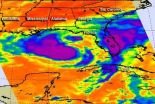(Press-News.org) Munich, Germany – August 28 2012: The risk of ischemic stroke one year after acute myocardial infarction (AMI) dropped by 21% over a ten year period, according to research presented at ESC Congress 2012. The analysis of data from two Swedish registries was presented by Dr Anders Ulvenstam, and suggests that the reduction is due to improvements in AMI care.
Ischemic stroke is a well known, relatively rare but potentially devastating complication following myocardial infarction. It can lead to severe neurological handicap and death for the patient and it is associated with great costs for society.
"The risk of ischemic stroke after myocardial infarction has been studied previously, but there are many questions that remain unanswered," said Dr Ulvenstam. "Many studies have been conducted within clinical trials but these trials tend to focus on a particular patient group. Few, if any, studies have been done on the broader group of patients seen in day to day clinical practice. We based our analysis on two registries which include all AMI patients in Sweden."
"Great variation in the incidence of ischemic stroke after AMI has been found in previous studies, which tells us that we do not have a realistic estimate of the risk of suffering from ischemic stroke after myocardial infarction," he added.
"Furthermore, many of the earlier studies were done before modern AMI care - with different drugs and interventional procedures- was established, which is why we do not know how this has affected the risk over time. There is also conflicting data regarding independent predictors of stroke risk."
The study presented at ESC Congress 2012 was based on 173,233 Swedish AMI patients between 1998-2008, from the Register of Information and Knowledge about Swedish Heart Intensive Care Admissions (RIKS-HIA). In order to identify which of these AMI patients suffered an ischemic stroke within one year, the RIKS-HIA database was merged with the Swedish National Registry, which contains diagnoses for all patients at discharge from hospital care.
Dr Ulvenstam said: "Based on this patient information we were able to answer the questions raised above, regarding the incidence, time trends and independent predictors of ischemic stroke at one year after AMI."
The researchers found that during 1998-2008 the average risk of ischemic stroke one year after AMI was 4.1%. This was nearly twice as high as the incidence found in an important meta-analysis performed by Witt et al. in 2006 which showed an average risk of 2.1% (1). Dr Ulvenstam said: "The higher incidence in our study could be explained by the fact that we have such an unselected patient group. The registries used exclude very few AMI patients which means that there are more potential stroke victims."
A second finding from the study was that the risk of ischemic stroke one year after AMI fell by 21% over a ten year period, from 4.7% in 1998-2000 to 3.8% in 2007-2008. "We are the first to show that the risk of suffering from stroke after AMI seems to be diminishing," said Dr Ulvenstam. "This is probably a direct result of the great improvement in AMI care which has taken place during the last two decades. For the first time we can see the impact of different drugs and interventional procedures on stroke risk after AMI."
The researchers also conducted an analysis of independent predictors of stroke risk. Multiple regression analysis showed for the first time that each of the following factors independently reduced stroke risk: reperfusion therapy with percutaneous coronary intervention (PCI), blood clot dissolving therapy (fibrinolysis), thrombocyte aggregation inhibitors (aspirin and P2Y12-inhibitors) and statins. Dr Ulvenstam said: "The finding that PCI actually reduces stroke risk is somewhat surprising, being an invasive procedure. It has traditionally been associated with an increased stroke risk. We speculate that early reperfusion of the myocardium reduces infarction size and thereby leads to a reduced burden of atrial fibrillation and heart failure and in turn, reduced stroke risk."
He concluded: "The risk of stroke after myocardial infarction is higher than previously thought, but seems to be decreasing with the modernization of coronary care. We predict that this risk will continue to decline if clinicians treat their AMI patients with the recommended drugs and interventions."
###
Contributors:
Anders Ulvenstam, MD1; Ulf Kajermo, MD2; Angelo Modica ,MD, PhD1; Thomas Mooe, MD, PhD1,3
1Östersund Hospital, Sweden;
2Kärnsjukhuset Skövde, Sweden;
3Umeå University, Sweden
References
1 Witt BJ, Ballman KV, Brown RD Jr, Meverden RA, Jacobsen SJ, Roger VL. The incidence of stroke after myocardial infarction: a meta-analysis. Am J Med. 2006;119(4):354.e1-9. Review.
Notes to editors
Please note that picture and CV from the author, abstract, picture and CV from spokesperson can be found here.
About the European Society of Cardiology www.escardio.org
The European Society of Cardiology (ESC) represents more than 75,000 cardiology professionals across Europe and the Mediterranean. Its mission is to reduce the burden of cardiovascular disease in Europe.
About ESC Congress 2012
The ESC Congress is currently the world's premier conference on the science, management and prevention of cardiovascular disease. ESC Congress 2012 takes place 25-29 August at the Messe München in Munich. The scientific programme is available at: http://spo.escardio.org/Welcome.aspx?eevtid=54
More information is available from the ESC Press Office at press@escardio.org.
Ten year decline in ischemic stroke after AMI
2012-08-28
ELSE PRESS RELEASES FROM THIS DATE:
Global platelet reactivity identifies high risk ACS patients
2012-08-28
Munich, Germany – August 26 2012: Global platelet reactivity is more effective than responsiveness to clopidogrel in identifying acute coronary syndrome (ACS) patients at high risk of ischemic events, according to research presented at the ESC Congress today. The results from the RECLOSE 2-ACS study were presented by Dr Rossella Marcucci from Italy.
The Responsiveness to Clopidogrel and Stent thrombosis 2 – ACS (RECLOSE 2-ACS) study is a prospective, observational, referral center cohort study of 1,789 patients with acute coronary syndromes undergoing percutaneous coronary ...
The raccoon spreads dangerous diseases as it invades Europe
2012-08-28
Furry, agile, intelligent and voracious: the raccoon is far from being a cuddly toy, which is what many people believe when they get one as a pet. It is more like an invader that escapes and is able to adapt and survive in new habitats. According to a study, its expansion across Spain and Europe is bringing infectious and parasitic diseases like rabies. This puts the health of native species and people at risk.
Originating in North America, the raccoon (Procyon lotor) is an invasive species that has established itself in Europe due to hunting and the fur trade along with ...
How 'beige' fat makes the pounds melt away
2012-08-28
The numbers of obese people are climbing steeply all over the world – with obvious major consequences for their health. Due to excess food intake and a lack of physical activity, but also due to genetic factors, the risk for overweight people dying from diseases like coronary heart disease, diabetes und atherosclerosis increases. "The body's fat reserves are actually used as a place to store energy that allows surviving lean times," says Prof. Dr. Alexander Pfeifer, Director of the Institute of Pharmacology and Toxicology of the University of Bonn. "But nowadays, hardly ...
Capturing movements of actors and athletes in real time with conventional video cameras
2012-08-28
This press release is available in German.In the computer graphics (CG) animated comedy "Ted," which is running now in the cinemas, Ted is a teddy bear who came to life as the result of a childhood wish of John Bennett (Mark Wahlberg) and has refused to leave his side ever since. CG Animated characters like "Ted" have become a standard of Hollywood's movie productions since the blockbuster "Avatar" with its blue-skinned computer-animated characters won three Oscars and brought in three billion US dollars, digital animated characters have become a standard of Hollywood's ...
ESC Acute Cardiovascular Care Association launched
2012-08-28
ACCA was previously the ESC Working Group on Acute Cardiac Care. Today it becomes one of six ESC Associations, whose presidents are invited to ESC Board meetings. "It will be easier to inform the ESC Board about the activities of the association," said Professor Christiaan Vrints (Belgium), outgoing chairman of the Working Group on Acute Cardiac Care. "We will also have a bigger impact on the policies and the development of the ESC as an organisation."
The Working Group on Acute Cardiac Care had the largest and fastest growing membership of ESC working groups. Over the ...
Study of tribe could help find East Asian skin color genes
2012-08-28
Genetic investigation of a Malaysian tribe may tell scientists why East Asians have light skin but lower skin cancer rates than Europeans, according to a team of international researchers. Understanding the differences could lead to a better way to protect people from skin cancer.
While the genetics of skin color is largely unknown, past research using zebrafish by Penn State College of Medicine's Keith Cheng, M.D., Ph.D., identified the gene in Europeans that differs from West Africans and contributes to a lighter skin color. Mutations in the genes SLC24A5 and SLC45A2 ...
Trudeau researchers identify unforeseen regulation of the anti-bacterial immune response
2012-08-28
Saranac Lake, N.Y. – August 28, 2012 — New research from the laboratory of Dr. Andrea Cooper at the Trudeau Institute, just published in the European Journal of Immunology, holds promise for the improved prevention and treatment of bacterial infections and the life-threatening complications of chronic inflammation that can result from them. The publication title is "Nitric oxide inhibits the accumulation of CD4+CD44hiTbet+CD69lo T cells in mycobacterial infection".
Following a typical bacterial infection, the immune response is manifested by the accumulation of immune ...
NASA watching Issac's approach to US Gulf Coast
2012-08-28
VIDEO:
An animation of satellite observations from August 26-28, 2012 shows Tropical Storm Isaac moving past the Florida Keys and into the Gulf of Mexico, nearing landfall in the U.S. Gulf...
Click here for more information.
NASA satellites have been providing valuable data to forecasters at the National Hurricane Center watching the development and progression of powerful Tropical Storm Isaac as it heads for landfall.
The Moderate Resolution Imaging Spectroradiometer ...
By detecting smallest virus, researchers open possibilities for early disease detection
2012-08-28
NEW YORK, August 28, 2012 – Researchers at Polytechnic Institute of New York University (NYU-Poly) have created an ultra-sensitive biosensor capable of identifying the smallest single virus particles in solution, an advance that may revolutionize early disease detection in a point-of-care setting and shrink test result wait times from weeks to minutes.
Stephen Arnold, university professor of applied physics and member of the Othmer-Jacobs Department of Chemical and Biomolecular Engineering, and researchers of NYU-Poly's MicroParticle PhotoPhysics Laboratory for BioPhotonics ...
Chinese credit card usage growing quickly, MU study finds
2012-08-28
COLUMBIA, Mo. — In the past two decades, the Chinese economy has undergone many drastic reforms in an effort to compete more effectively on the international market. These reforms included allowing foreign banks to offer credit cards to Chinese citizens. Now, researchers at the University of Missouri have found about 30 percent of Chinese urban households now own at least one credit card and the growth rate of credit card adoption has been an average of 40 percent per year between 2004 and 2009.
Rui Yao, an assistant professor of personal financial planning in the College ...




